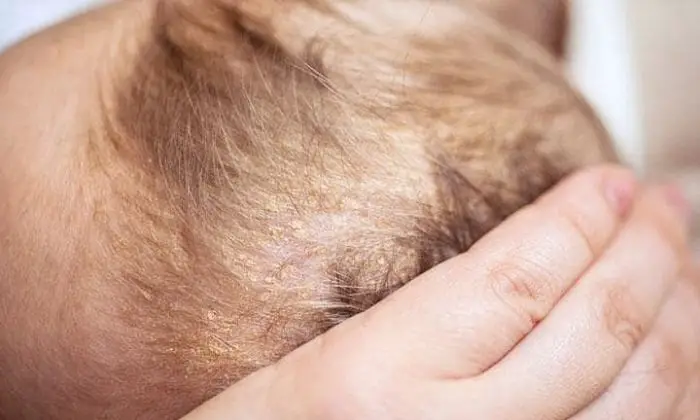
Cradle cap is a disorder identified by white or yellow, fatty or dry scum, affecting individuals regardless of their age or gender. Although it is most infamous for affecting babies.
Dandruff and scaly patches are, both, forms of cradle cap. This is not a contagious disease, but getting rid of is hard and requires a lot of patience.
The best thing for cradle cap, usually, involves a combination of several products containing active ingredients which diminish the visible effects of this condition.
An important aspect is to understand the stages and signs, of this illness, in order to correctly choose the number of active ingredients, you shall look for, in a cradle cap remedy. Also, make sure you follow the right steps when applying the products.
Cradle Cap: Diagnosis and Causes
Medically known as “Seborrheic dermatitis”, this disease is, usually, found on the scalp, eyebrows, forehead and even on the face. Another location may be behind or inside the ears. In most cases, the disease starts along with the puberty period.
The factors, causing cradle cap, are not yet known, but there are some factors considered to create a favorable environment for the presence of this skin inflammation, among which there are:
- The genetic factors
- High-stress levels
- Low temperatures
- An infection with human immunodeficiency virus (HIV)
- Certain neurological conditions such as Parkinson’s disease
- The long-term use of some medicines
Seborrheic dermatitis can be also found in newborns; this particular form of a disease being characterized by the following aspects:
- Scalp lesions similar to the yellowish scalp;
- White or yellow injuries located behind the ears;
- Red papules on the face;
- Skin lesions, specific to dermatitis, located in genital and buttocks (dermatitis diaper) that does not show improvement in the treatment.
Cradle Cap: Symptoms
In the beginning, the manifestations, of this disease, appear progressively throughout the course of the illness. Initially, it starts with the peeling located on the scalp (dandruff), which may be dry or greasy, accompanied by some skin matter.
In the advanced stages of this disease, some papules will appear on the surface of the skin, having a yellowish-red color, localized predominantly at the level of the hair implant line, eyebrows, and retro-auricular grooves, in the axillary or sternum region. In some cases, it may also appear some dry crust in the region of the eyelashes.
The Best Thing for Cradle Cap: Shampoos, Lotions, and Gels
In adult seborrheic dermatitis, is recommended to use daily or, at least, once every two days, hair shampoos containing selenium sulfide, zinc, sulfur, tar or salicylic acid.
After removing dandruff, it is recommended to reduce the washing frequency and use these types of shampoos once or twice a week. Apply a corticosteroid-based lotion on the affected area, to make the scuffing injuries disappear. Among the best lotions for cradle cap, choose one of the following:
- a lotion with 0.05% triamcinolone acetonide;
- a lotion with 0.01% fluocinolone acetonide.
This type of solutions can be used once or twice, every day until the lesions disappear. In the case of seborrheic dermatitis located at the level of the nasolabial folds, behind the nose, ear or at the eyelid margin, a cream with 1% hydrocortisone should be applied daily, two or three times a day, until the skin lesions disappear.
Unlike other face creams, administered in the case of seborrheic dermatitis, containing fluorinated corticosteroids, hydrocortisone facial creams do not cause any side effects.
In the absence of response to the above-mentioned medicinal products, lotions with 2% ketoconazole are recommended or other creams based on imidazole.
These will be applied, directly on the inflamed lesions, twice a day. The duration of this treatment is usually between 1 and 2 weeks. Studies have shown that the treatment with imidazole leads to a long-term remission of skin lesions.
In case of seborrheic dermatitis located on the eyelid edge, on adults, it is recommended to apply a small amount of diluted baby shampoo designed for cradle crap.
In infants diagnosed with an easy form of seborrheic dermatitis, it is recommended to apply, twice a day, a cream containing 1% hydrocortisone. You should use, daily, a specially designed shampoo for babies with cradle cap.
In the case of newborns or infants diagnosed with severe seborrheic dermatitis, having thick desquamation lesions at the scalp’s level, it is recommended to apply, directly on the lesion, a gel containing 2% salicylic acid or corticosteroids and olive oil.
Apply the gel before putting the baby to sleep. Wash the baby’s scalp daily, with cradle cap shampoo, until the skin lesions disappear.
Steps on How to Correctly Apply Cradle Cap Products
- Using a shampoo. The shampoo’s brand, you are planning to use, is not as important as how you rub the scalp. The crust should be removed gently with your nails while washing with shampoo. Make sure you rub the scalp for at least 5 minutes.
- Using a lotion or gel. To efficiently apply the cream on the scalp, the hair should be split up into a few strands and the lotion should be applied by vigorously rubbing the scalp.
Final Thoughts
There are no restrictions in terms of physical activity, on contrary, it is recommended to reduce stress levels, which may be favorable for cradle cap development.
Outdoor activities during the summer can be useful. When dealing with cradle cap, there is no special diet used as a treatment, so don’t push yourself following dietary recipes found on beauty sites.
It is not a contagious disease, but it can be disturbing from an aesthetic matter, leading to emotional disorders. Keep in mind that you are not the only one dealing with this situation since this condition affects 15 – 20% of the population.
Following the right treatment, with the right percentages of active components and having patience is, in most of the cases, the right thing to do.
It is necessary to consult a specialist when severe seborrheic dermatitis symptoms occur, when seborrheic dermatitis lesions have a yellowish secretion under the crust or a heavy pus leakage, suggesting a bad infection that requires specialized treatment.

